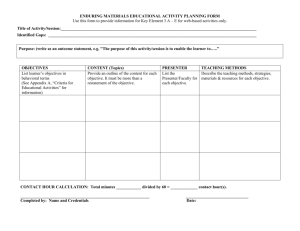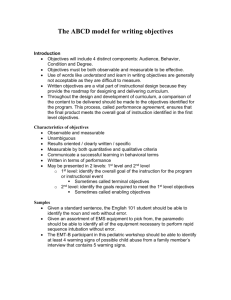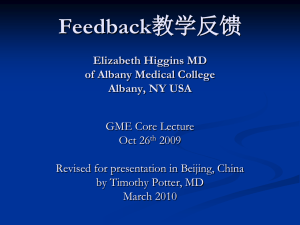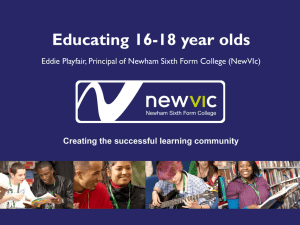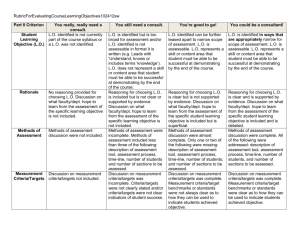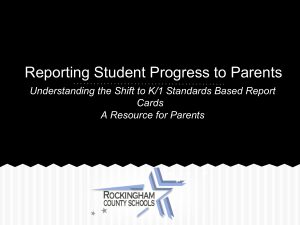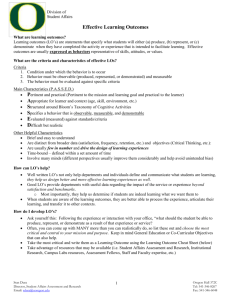Ms. Bennett`s Powerpoint Presentation
advertisement
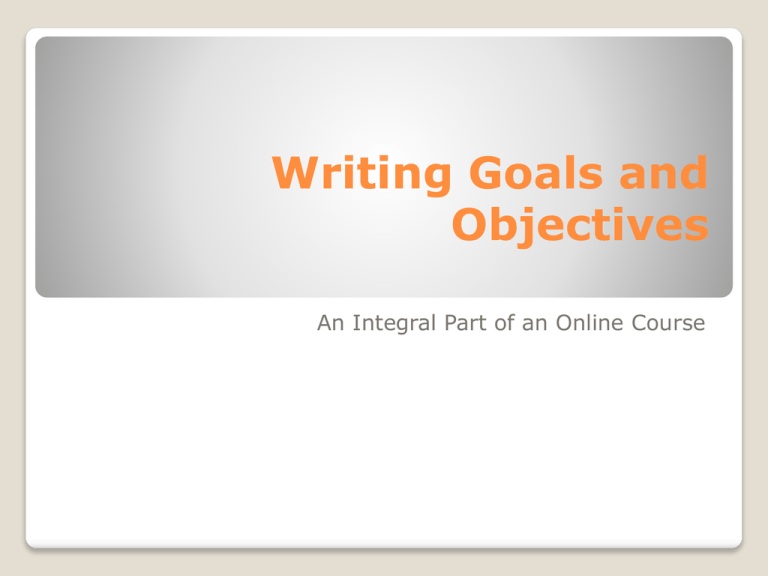
Writing Goals and Objectives An Integral Part of an Online Course At the end of this presentation you will: Identify the essential characteristics of measurable course learning objectives. Compare and contrast educational goals vs. educational objectives Write clear, measurable educational objective using the ABCD model Gain knowledge to develop educational objectives that focus on the learner as the intended audience Objectives for this Presentation Benjamin Bloom and his colleagues published a taxonomy of learner behaviors which was taken into the public schools and eventually adopted in the health profession schools. It has influenced curriculum development and driven the movement towards competency based instruction for health professionals. Bloom. B. and Krathwolh,D. (1956) Taxonomy of Educational Objectives:The Classification of Educational Goals , New York, Longmans 1956 Educational Objectives are also called: Learning Objectives Outcomes Terminal Objectives Performance Objectives Competencies Instructional Objectives Behavioral Objectives The use of the terms “goals” and “objectives” can be confusing! Let’s clarify the differences. GOALS OBJECTIVES Broad statements Specific General intentions Precise Intangible Tangible Abstract Concrete Generally hard to measure Measurable The Difference Between Goals and Objectives Goals: knows about the human body. Objectives: SWBAT name all of the bones in the human body as stated in the medical textbook "The Human Body" Goals & Objectives Example The goal of a learning activity is like a target Goal The objectives are the arrows that help the learner reach the target and demonstrate mastery Objectives A. State the definition of a complimentary medical intervention or therapy. B. Provide the health professional with the latest information about over the counter (OTC) anti- histamines and their side effects. C. Introduce the reader to a new development in the early detection of oral cancer. D. Be exposed to a new way of organizing paperwork. Can you identify the Goals? There is only one objective on the previous slide- A. State the definition of a complimentary medical intervention or therapy. The rest are all broad based goals! Clue: Every educational activity should have a goal The goal focuses on what the learner will experience, rather than what the instructor will share or do It is a broad statement of purpose A few things to remember about goals ALWAYS BEGIN WITH THE END RESULT IN MIND! Be SMART The Components of an Objective Criteria Description Questions Specific Is there a description of a precise behavior and the situation it will performed in? Is it concrete, detailed, focused and defined? Measurable Can the performance of the objective be observed and measured? Achievable With a reasonable amount of effort and application can the objective be achieved? Are you attempting too much? Relevant Is the objective important or worthwhile to the learner? Is it possible to achieve this objective? Time-bound Is there a time limit, rate number, percentage or frequency clearly stated? When will the objective be accomplished? Be SMART The ABCD method of writing objectives is an excellent starting point for writing objectives (Heinich, et al., 1996). In this system, "A" is for audience, "B" is for behavior, "C" for conditions and "D" for degree of mastery needed.* *Taken from Penn State University Online: http://ets.tlt.psu.edu/learningdesign/objectives/writingobjectives The ABCD Approach Who is this activity intended for? Be specific! At the end of instruction, the students will be able to..... As you target a specific audience with your objective make sure that you are meeting the needs of all learners in that group. A=Audience (the learners, readers or participants, not the instructor) What exactly is it that you want the learner to be able to do as a result of your ... The behavior is the action (verb) that describes what the learner (audience) will be able to do after the instruction. B=BEHAVIOR (what the participants will do) *http://edtech2.tennessee.edu/projects/bobannon/helpful_hundred.html Behaviors for educational objectives fall into three categories, called domains Cognitive: Dealing with intellectual abilities; Approximately 80% of educational objectives fall into this domain; Most familiar to both instructors, authors and learners Affective: Relating to the expression of feelings, including emotions, fears, interests, attitudes, beliefs, values and appreciations: Often the most difficult objectives to develop Psychomotor: The easiest objectives to write as the behavior is easily observed and monitored. Psychomotor skills often involve the use of tools or instruments;“ Hands On” courses will contain psychomotor objectives What type of behavior do you want? States what conditions the instructor will impose when the learners are demonstrating mastery of a skill. Usually a WHEN or WHILE statement “when given a set of five unlabeled slides” “while working independently” What will the student be given or already be expected to know to accomplish the learning? C= Condition (imposed by the instructor) The standard or criterion for judging the behavioral performance. What has to happen for the learner to succeed? It might be: Speed Accuracy Quality Quantity D=Degree What is “Good Enough”? Can you breakdown the objective? Using the job aid the instructor will successfully write a learning objective that is observable, measurable, and clearly defined. Objective Breakdown Quality Learning Objective-The Breakdown “When given a list of 20 words, the learner will be able to identify correctly all the cognitive action verbs”. Audience “the learner” Behavior “identify” (based on Bloom’s Taxonomy) Condition “when given a list of 20 words” Degree “all” (100%) Example A clearly stated learning objective can serve two additional functions: imply a suitable teaching method; and lead directly to a suitable assessment method. Additional Benefit Questions and Answers http://online.fiu.edu/faculty/syllabusdevelopment/learningobjecti ves http://tulane.edu/publichealth/mchltp/upload/Tips-for-writinggoals-and-objectives.pdf http://www.iom.edu/About-IOM/Making-a-Difference/CommunityOutreach/~/media/Files/About%20the%20IOM/SmartBites/Planni ng/P1%20SMART%20Objectives.ashx Resources

